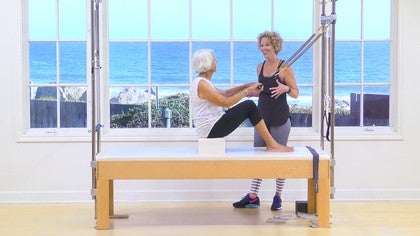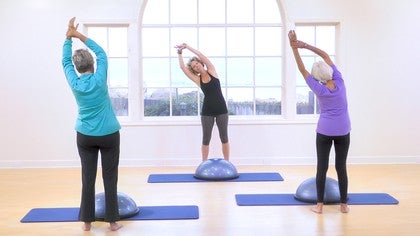Description
About This Video
Transcript
Read Full Transcript
Hi everyone. I'm Erica quest. I'm here to talk to you today about active aging, mobility and stability. So these folks are often termed seniors, right? We don't like that word. I like to call them the chronologically enriched. With that being said, I want to talk about center sense, right? And the science of aging.
This is quite important in my opinion because the active aging community, you as an active ager should be very interested in knowing these types of aging. So there are four types of aging. There is your chronological age, which is your actual number of years that you've been on the earth. For me, it's 38. So I've been here 38 years. Secondarily, there's your functional age or the age, um, uh, your ability to perform ADL d or activities of daily life. So your daily lifestyle, that's your functional age. Third Age would be your physical age, or excuse me, your third age would be your biological age. And this would be on a cellular level.
So if we took a thin slice of your blood or yourselves and we analyzed it and we looked at how many antioxidants were in your bloodstream and Yada, Yada, Yada, a whole bunch of other types of things, we could find out what your biological age would be. And that tells the story. It could be less than your chronological age or it could be more than your chronological age. And then fourth in line is your psychological or your cognitive age. And this has to do with a lot of your neural pathways, your reaction time and those types of things. So [inaudible] you probably thought that I sounded like a five year old kindergartener trying to say the word sentence, but no, it's senescence and that's basically the science of aging.
So I want to read you a quote and this is really, really amazing. People who exercise regularly with task dependent exercises, which we're going to call games, have lower biological ages than people of the same chronological age who do not exercise. So when we combine, um, exercise, mental and physical exercise or games or sequences, we are in a space where we can actually lower your biological age. So let's say you're 72 or 55, but we look at your biological age because you've been doing these really great things for both your brain and your body. You could technically be several years less in biological years, which is pretty exciting. This is also a huge point of self efficacy as an active ager.
So self efficacy is really gate improvement, fall prevention, better, um, better ADL or active daily living, active daily lifestyle. Uh, it is also a better reaction time. And this just promotes overall wellness and confidence. I mean, I think about my grandfather, he lived well into his nineties, and he daily as a ritual would go for a three mile walk and then he would also pick up the comic pages and he'd sit down and read the comics. Then he would sit there and do his crossword puzzle and his word search every single day. So he was really bridging that gap of, you know, physical as well as mental. Now here, we'd like to try and do some of those things, these games or sequences together so that we're really helping marry those two elements. So how do we promote self efficacy? Well, as in the, in the active aging world, the two main things that we need to talk about reach research says is strengthening, strengthening of the quadratus lumborum and also strengthening of the anterior Tibialis. So with the quadratus lumborum Schoenfelder says that the number one reason to help strengthen that is it really helps with the senior shuffle. And then as far as the anterior Tibialis, meaning lifting of the toes into Dorsi flection, which we actually do a lot of plant reflection in Palladia.
So it's interesting to see how lifting of the toes will really help with reaction time and ball prevention. So some of the Games and the sequences I'm going to show today are geared around strengthening the quadratus lumborum as well as the anterior Tibialis. Uh, some of these sequences are definitely able to be a part of your comprehensive Polonius programming, which is wonderful. It doesn't have to be the totality of things. It can just be two or five minutes, which is great. So I encourage you to try these at home and just experience them for yourselves.
Some of the considerations of activators. And believe it or not, this reaches down to 50 plus. Now I'm not saying that 50 is, you know, is old by any means or senior, but just so you know, that's what the research has denoted is that 50 pluses considered the active aging population. Some of the considerations would be certainly bridging. We'll talk about some ways to safely bridge in a moment, uh, because blood pressure starts to play a role here. So low but low blood, blood pressure as well as high blood pressure. So you want to be careful with keeping the heart, uh, or excuse me, the heart above the head or the head below the heart, uh, for long periods of time or if at all. Uh, additionally you want to make sure that you're thinking about still mobilization of the spinal column here and that includes the cervical spine. But with the vestibular process, you want to make sure that you're trying to move those cervical spine, the cervical spine just a little bit slower and in, in this case. And then in addition to that, oftentimes the cognitive response time can be a little bit slower.
So therefore you need to be patient as an active ager or you just need to think about, you know, just taking a deep breath and relaxing into the movement a little bit more and just realizing that it will come. And then finally, in the scheme of doing, um, a session, the systemic warmup for this, this group of people is often 20%. So you want to think about, uh, taking the time to do a longer warmup for yourself as you, as you are then beginning to move into some games or sequences. Uh, I want to talk a little bit about the Bosu and the Bosu balance trainer, which we're going to be using today for some of these games. And it's a wonderful tool just from a biofeedback standpoint. It really offers a, a balanced challenge. And some of these exercises, it allows for the foot to Dorsiflex nicely with a nice soft and stable surface, allows for getting up and getting down easily and a, so we're going to be using that today. However, I want to let you know that you really don't need this.
You could certainly eliminate the Bosu and you could actually do many of these games or sequences on the floor. Or if you have another balance product or a balanced disc, that's absolutely fine too. So with that being said, I'm going to show you a few exercises that work in the sagittal and the frontal plane for the quadratus lumborum as well as the anterior to be Alice. And then we're going to move into the safe bridging and a way to get down into safe bridging. Okay, so starting with some of the exercises or the gains sequences that we're gonna move through today, we're going to start, typically I'd be actually back behind my Bosu Butt so that you can see this. I'm off to the side. We're going to be moving in the sagittal plane. And the first thing is just to start to get comfortable with your Bosu dome and the inflation of it.
So the best thing to do is to put your foot up so that you're in a slight Dorsiflex foot. And just start with some gentle ankle mobility, just some rolling of the ankle and rolling it in the other direction. And you can do this as much or as little as you'd like just to start to feel things. And you also have to realize that you're now also using a leg to stabilize on the floor. And then we're going to start to do a game that we call bubble wrap. Okay? So from here, all I want you to do is just lift that foot and tap and you're just going to gently tap all over your Bosu dome. And if you're comfortable, just go ahead and leave your hands up or on your hips.
It depends on how you feel and think about where your visual field is. Do you need to look down to do this? Can you have your visual field a little bit more lifted? Right? So you're just feeling the inflation of your dome at this point in time. And then once you've done, you know, 10 15 of those, and let me preface this, I'm only showing this on one side.
You would definitely want to do this on the other side so that your body and your brain is balanced. Then we're going to start to get a little bit more aggressive here. So you're going to actually put one foot down and what you're going to do is some rocking. So this simulates a lunge in the sagittal plane. So you have the front foot in a dorsiflex position so that the toes are slightly upwards towards the knees and you're just going to start to bend and rise up and bend and rise back. Now I'm in a pretty easy foot position. If you wanted to challenge yourself into a deeper lunge, you just slide that back leg a little bit further back, right?
So you just want to set the back leg further and then you're just going to go ahead and drop down and lift, drop down and back. So you're just doing some gentle rocking and you can see how challenging it actually is just to have one foot on the Bosu dome and one foot on the floor. Okay, so we're simulating a little bit of lunging in the sagittal plane. And then from here we want to start to do a little bit more of a reaction drill. So before we actually start the catch portion of it, I just want you to kind of like press a little bit more vigorously into that boasts you dumb and start to feel the biofeedback here.
And you can breathe sometimes putting the tongue up on the roof of the mouth. That really helps with this. And the final thing here is called catch yourself. So this is great for fall prevention and what you want to do is you want to lean forward and then boom, catch yourself. Okay, lean and then catch. And it's actually a little bit scary, lean and then catch, right? So all of this work is done for the anterior to be allies and we're working in that sagittal plane. Okay? So we're going to emulate some of this scene work, turning and facing so that we're now in the frontal plane. Okay.
You're gonna stand next to your Bosu dome and we're going to do the same thing. So you're going to bring your foot up onto that Bosu dome and just do some gentle ankle mobility. Okay? Yup. Rolling in one direction. Of course. Rolling in the other direction. So now we're focusing on the QL or the quadratus lumborum. So from here you're going to do the same thing as we did before.
And what I want you to do is just a little bit of pressing and pushing off, finding a little bit of different areas, surface area, and do you need to look over there? Can You keep your foot, your visual field up on the horizon and just feel safe about what you're doing? Or do you need to look over there? Right? Just different, different for everybody. And then from here, after you do that as sort of an experience, what we want to do is go ahead and put your foot on that dome and we're going to just start to push in. Now, shoulder girdle here stays nice and square and all I want you to do is start to rock your hips, right? Just to start to activate that QL here on the right side. So you're first doing the side with the foot that's on the dome, activating and really working that hip and then coming back to neutral every time you're going to then reverse it and activate the QL on the foot that's on the floor. So you're going to push into the hip that's on the floor, push in and try and keep the shoulder girdle. Again, nice and level on the pelvis coming out of neutral, but then coming back to neutral, right? So pushing in, pushing in, and so that's really getting the QL to start to activate. Then from here we're going to experience kind of what we did in the sagittal plane, but in the frontal plane with side lunging.
So you're going to step away a little bit. And then from here you're just going to take a step in and back, getting a little bit more vigorous again with this pushing, getting that queue out activity and really being aware of it. So like you know, five to 10 and then finally the same catch yourself drill comes in the frontal plane. So from here, instead of leaning forward, you're going to know lean to the side and catch yourself right at the last second. You want your foot to come down, activate that QL and really work on your reaction time. And I'm telling you that actually it's especially with your visual field facing forward, it can be a little bit scary. So just play with where your eyes are and play with where your vestibular processes and just have fun with it.
An easy way to get down onto the boast you don't is to face it because we're going to now go into how to safely bridge. You're going to softly bend your knees and start to come into a little bit of a squat. As you reach down, you're going to touch the boast you don't with the fingertips. And then the lean the knees into the soft dome and you're now in a floor position, which is great. Okay, from here you can do a myriad of games and sequences, which we're not going to go through. I'll give you a resource at the end. Um, but then you're going to come down to a seated position and slide your glutes all the way onto the floor or the table. You could have this dome up onto a table, but of course you'd want to be a little bit more cautious about that. When you're elevated and you're going to lie down, your neck and shoulders are nicely rested on the dome.
So remember we talked early about the, um, things to be concerned about as far as the blood pressure and about the head being below the heart. Well, now you're in a very safe position to bridge. Your feet are going to be about hip distance apart parallel so that you're in alignment structurally from your hips to your knees, to your ankles. Your arms are nice and relaxed down by your sides. And on an exhale you're just going to push through those hills and bridge up. Okay, dropping the Tush and bridging up, dropping and bridging. And again, you can do five to 10 of these and then just change it for your neurotransmitters.
It's fun to change the foot position so you can press up onto your toes and do some bridging up onto your toes and feel how that feels. And then you can go onto your heels and Dorsiflex the foot and lift. And then you can alternate. Go onto one toe and lift the opposite
You're going to extend the right leg out and you're going to push through that left heel. Really activating the glute muscle here and your hamstring. This really helps with gait and fall prevention and strength of course, and you live, so maybe five to 10 on each side. And then once you're done with that, you'd roll off to one side and go ahead and get up safely. Now, as I said before, there's a resource here for you if you're interested at all. A dear colleague in front of mine by the name of Lawrence discontinue has developed a lot of wonderful active aging, uh, games and sequences.
If you'd like further information and a breadth of information, you can absolutely find him@findlawrence.com and that's l a. W. R, e, n. C. And with that being said, I'd like to say, I guess we're all actively aging, so cheers. Let's actively age well together and um, thanks for watching. Go be awesome.
The Teacher's Corner: Working on Neuroplasticity
Comments
You need to be a subscriber to post a comment.
Please Log In or Create an Account to start your free trial.
























